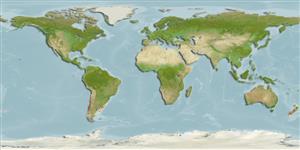Common names from other countries
Classification / Names / Names
Common names | Synonyms | Catalog of Fishes (gen., sp.) | ITIS | CoL | WoRMS
Environment: milieu / climate zone / depth range / distribution range
Ecology
Benthic; depth range 5 - 32 m (Ref. 87801). Subtropical
Southwest Atlantic and Southern Pacific.
Length at first maturity / Size / Weight / Age
Maturity: Lm ? range ? - ? cm
This is found on polychaete tubes, dead gorgonians, bivalve shells, and rocky hard substrates on vertical slopes with significant water current at depths of 5 to 32 m (Ref. 87801).
Life cycle and mating behavior
Maturity | Reproduction | Spawning | Eggs | Fecundity | Larvae
Members of the order Anthoathecata are mostly colonial A-form hydroids. Life cycle: The zygote develops into planula inside the gonophore and is later released as an actinula which metamorphoses into polyp stage.
Bouillon, J., C. Gravili, F. Pagès, J.-M. Gili and F. Boero. 2006. (Ref. 8278)
IUCN Red List Status (Ref. 130435)
CITES status (Ref. 108899)
Not Evaluated
Not Evaluated
Human uses
| FishSource |
Tools
More information
Age/Size
Growth
Length-weight
Length-length
Morphology
Larvae
Abundance
Internet sources
Estimates based on models
Preferred temperature
(Ref.
115969): 14.2 - 16.5, mean 15.4 (based on 128 cells).
